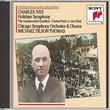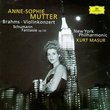| All Artists: Robert Schumann, Kurt Masur, London Philharmonic Orchestra Title: Robert Schumann: Symphonies Nos. 1-4 Members Wishing: 0 Total Copies: 0 Label: Teldec Release Date: 9/6/1994 Genre: Classical Style: Symphonies Number of Discs: 2 SwapaCD Credits: 2 UPC: 745099550127 |
Search - Robert Schumann, Kurt Masur, London Philharmonic Orchestra :: Robert Schumann: Symphonies Nos. 1-4
 | Robert Schumann, Kurt Masur, London Philharmonic Orchestra Robert Schumann: Symphonies Nos. 1-4 Genre: Classical
|
Larger Image |
CD DetailsSimilarly Requested CDs |
CD ReviewsThe original 1841 d minor symphony - good solid performance kreisleriana16 | Minneapolis, MN USA | 11/21/1999 (5 out of 5 stars) "comparison: Norrington (out of print)This review will concentrate with the rarely heard d minor symphony though the entire set is excellent. Masur and the London Philharmonic work well together. For those who are not familiar with Masur's conducting, he does not use a baton (or at least didn't in a PBS telecast of the Rhenish Symphony with the NYPhil). He is also held somewhat as a hero in Germany due to his anti-Communist views in those dark days when Leipzig was still in East Germany. Masur was the musical director of the Leipzig Gewandhaus Orchestra during that period. This is the second readily available commercial recording of the d minor Symphony. Most of us are familiar with what was to become the Symphony no.4 in d minor, opus 120 which the album lists this work as. That is a mistake as there are some major differences between the original and revised and final version. The original came to my attention when as a student we performed the 4th Symphony. As it turned out the 4th Symphony became a favorite of mine with the Furtwangler recording becoming my standard performance to judge all others by. The 4th is almost too rich in its thick texture. Schumann, it is told, was not the best conductor and in some places tripled solos so that if he missed the solo oboe's cue the cello's would also have the same material. The primary differences are in the first and final movements with some drastic changes in instrumentation and melodic patterns. Clive Brown writes in the notes for the now thankfully deleted Norrington version that the changes are "largely confined to the orchestration . . (and) the first version has almost a chamber music quality. . .". In some ways he is correct. I suppose one could compare the final version as a full course meal with a lot really rich food. The original is not really low calorie neither but isn't as overfilling.It is true that Schumann did take care of some of the original's deficiencies which do become apparant when one listens to it. What Clive Brown misses is the fact that the original has its tempo markings in the traditional Italian; the revised and well known version is in German. This is an important change as the second movement, for example is marked "Andante" while the revised is "Ziemlich langsam". The first movement is listed as Ziemlich langsam - Lebhaft, while the original is Andante con moto - vivace. Unless I am wrong, "langsam"means "slowly". Here again, Norrington flys through the Romanze in 3 minutes and ten seconds; Masur takes twenty-four seconds longer!This is reflected in the timings of both the Masur and Harnoncourt performances or the original where the tempo in the first movement is quite brisk. Norrington, who seems to always have a problem with slow movements, reads the revised version as if it was the original and second movement faster than both of the original performances. To be sure, the revised version is best heard with such conductors as Furtwangler, Bernstein, or Kubelik to name a few.Masur's performance is what to be expected: very good. The orchestra performs admirably. I suspect that this is a far more difficult work to perform than the final version which is so thick that any problems might be easily covered up. The violins, for example, have a lot of support work to do for the woodwinds in the first movement instead of simply doubling in on the melody with the winds. The faster tempo in the first movement makes sense too when you consider the differences between the original and revised in instrumentation, melodic layout and the language difference. Also not as much noticed was that favorite Schumannesque trembelo in the strings at places. It's there but not as much as in the final version.All though Schumann did not make too many changes in the second and third movements as stated there are some interesting observations that can be made in the third: wind parts that are exposed in the second subject of the main section as well as a slight slowing down in the second subject before the return to the first. The other matter is the second movement: the solo instruments are exposed more. As in the rest of the original the woodwinds are not hidden behind a lot of layers of strings. There has been some discussion of a missing guitar part that Schumann supposedly wrote in the second movement both by the conductor at the university I went to as well as a conductor I heard in a live performance. I'm not sure if the part was for solo or to accompany but if anyone finds an old guitar part written by Schumann in their attic kindly let us know.This is a set well worth having. The price is medium with two CD's in one package. For that matter just hearing the original d minor alone is just about worth the price." Masur's View of Schumann's Symphonies John Kwok | New York, NY USA | 05/15/2001 (5 out of 5 stars) "Without question, these are among the finest recorded performances of Schumann's symphonies. Most noteworthy is Masur's usage of the original (1841) version of Schumann's 4th Symphony in d minor. The textures are leaner, and the performance more akin to that from a chamber orchestra than a symphony orchestra. Equally compelling is Masur's reading of Schumann's 3rd Symphony. Under Masur's leadership, the London Philharmonic gives vibrant, technically perfect performances that are a far cry from the Vienna Philharmonic's exuberantly warm performances of these symphonies under Bernstein's baton. Masur's tempi are faster than Bernstein's but do not sound rushed. Anyone interested in a great set of Schumann's symphonies shouldn't overlook this set." Great quality; some movements taken too hastily. W. Crone | Northern CA USA | 01/23/2003 (4 out of 5 stars) "I love the symphonies of Robert Schumann. In spite of what is often said of his lack of skill in the area of orchestration it would be difficult to deny his ability to create wonderful lyrical music. The version offered here by Mr. Masur and company is a fine recording in many respects. The performances themselves are wonderful and the recorded sound is quite crisp and ever present.My only gripe is with the tempi. In one of my favorite movements, the adagio espressivo (Mvt 3) from the C major symphony, the piece trots along at a pace I find difficult calling adagio. This rendering is done in a matter of 8 minutes even. I have listened to versions taking as long as 11 and-a-half minutes. In my opinion the Masur performance is too fast but that's just me. If you don't own a complete set of Schumann symphonies then this set will serve you well. If you already own a set or two (or more as in my case) then pick this one up anyway on principle alone...the price is quite good."
|

 Track Listings (8) - Disc #1
Track Listings (8) - Disc #1





![Anne Sofie von Otter - La Bonne Chanson [French Chamber Songs]](https://nationalbookswap.com/cd//m/21/0221/6010221.jpg)

